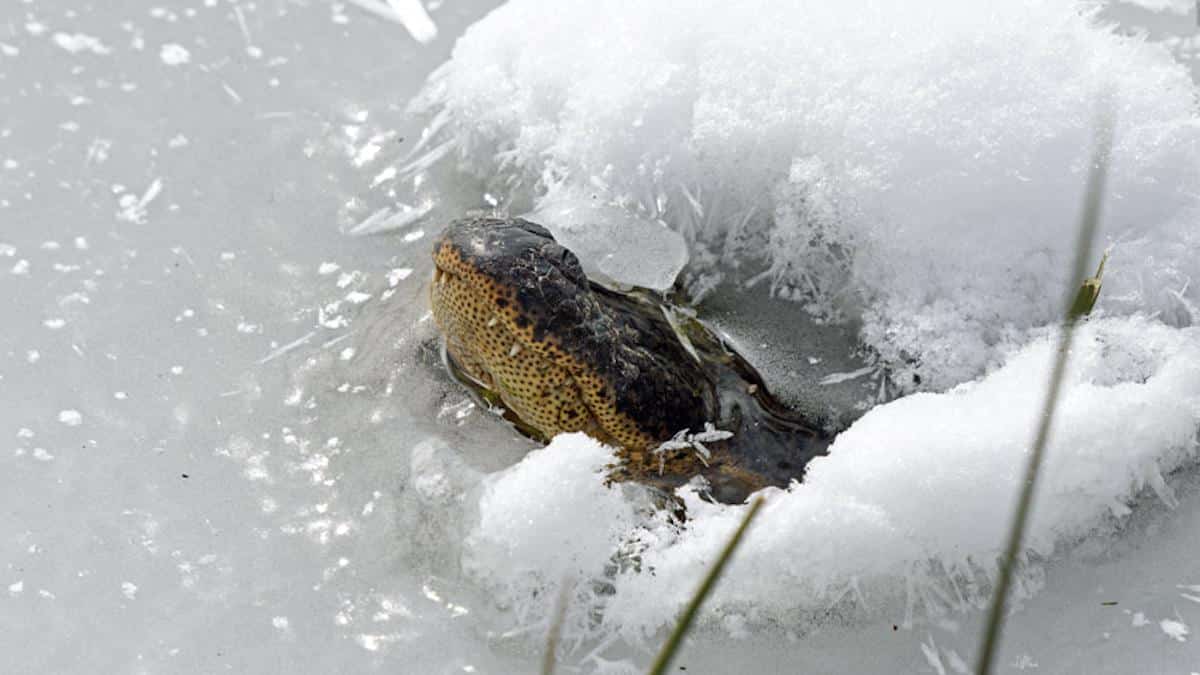

Photos of alligators engaged in "icing" were posted on Facebook by an Oklahoma Department of Wildlife Conservation worker. David Arbour / Oklahoma Department of Wildlife Conservation
As unusually cold temperatures descended on the south and central U.S. this week, it wasn’t only humans who struggled to adjust.
In Texas, sea turtles had to be rescued by the thousands as cold water temperatures made them go limp. Now, in Oklahoma, alligators have been pictured engaging in an extraordinary survival technique.
That technique is called “icing,” and David Arbour of the Oklahoma Department of Wildlife Conservation posted photos on Facebook Tuesday of alligators engaging in this odd-looking strategy.
What is icing exactly?
“They keep [their] nose up through the ice to maintain a[n] air hole so they can breathe,” Arbour explained in the comments.
Arbour took the photos in the Red Slough Wildlife Management Area, a 5,814-acre wetland in southeastern Oklahoma that is home to alligators as well other reptiles, fish, mammals and amphibians, the Tri-City Herald reported.
The behavior is also called snorkeling, and this is not the first time it has been observed in American alligators (Alligator mississippiensis). Alligators in a frozen-over pond in North Carolina were pictured doing the same thing during a cold snap in 2018, LiveScience reported at the time.
Because alligators are cold blooded, they depend on the surrounding environment to keep warm. That is why they bask on sunny days. But when it freezes, this kind of basking isn’t possible, and that is when they “ice.”
“It’s an interesting behavior because it’s opposite of what most crocodilians do,” James Perran Ross, a retired associate scientist of wildlife ecology and conservation at the University of Florida, told LiveScience. “The normal response of most other crocs when it gets really cold is to come out of the water and try to bask to get warm again.”
However, Ross added, this would be a bad idea for alligators in a cold climate, since the air is usually colder than the water. If they left the water, they might freeze.
Arbour wrote on Facebook that the alligators in his pictures would not freeze as long as the water remained liquid. He added that the ice did not hurt their snouts, because they are only made of cartilage.
Instead of hibernating, Arbour wrote, alligators enter a state called brumation.
“They can still move and are aware of things,” Arbour said.
Brumation is a reptile-wide response to cold weather, according to Science Alert. The animals slow down their metabolism and are very lethargic. Usually, alligators brumate at the bottom of swamps and come up once a day to breathe. When water freezes over, however, that is not possible.
Alligators can survive in water as cold as 40 degrees Fahrenheit, but it is not ideal.
“Obviously, that is not optimal, being frozen like that,” North Carolina’s Shallotte River Swamp Park general manager George Howard told HuffPost in 2018, when alligators were videoed icing in his swamp. “I can’t imagine it being very good for them if it was much over a week in cold water. That’s why you don’t see indigenous alligators north of North Carolina. Their bodies like the warmth.”
In Oklahoma, temperatures have now been below freezing for 10 days as of Thursday, according to WLBT3. However, the Southern Plains are expected to finally thaw this weekend, according to the National Weather Service.
- Is Winter Miserable for Wildlife? - EcoWatch
- Why Do Crocodiles Today Look the Same as They Did 200 Million ...

 233k
233k  41k
41k  Subscribe
Subscribe 